
Needle and Suture Pages: 1 2 3 4 5 Next>>
Needles and Suturing in the Golden Age of Piracy, Page 2
Suture Instruments: Scissors
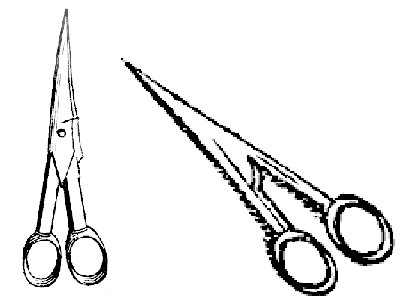
Suture Scissors, figured in Pierre Dionis' Course. Left: From Fig IX, For
Gastrorhaphy, p. 74,
Right: From Fig VII, "Of Sutures", p.59 (1740)
Scissors would also be necessary for snipping suture material, although they are not widely discussed in the period texts. When discussing medical practices from this time, surgical historian John Kirkup commented, "The few scissors with asymmetrical blades are usually employed for cutting sutures, bandages, or plasters, and have one long, probe-pointed blade to engage these materials without engaging subadjacent tissues."1
French surgical instructor Pierre Dionis provides figures of two scissors meant for snipping sutures (or 'thread' as he refers to it.) Neither of them have asymmetrical blades; in fact, they look like typical scissors from the period. Of the pair on the left, Dionis discusses their use in cutting a knotted thread where "with a good pair of Scissars... he [the surgeon] cuts this String a Finger's breadth beyond the Ligature"2. Of the pair on the right side of the image, Dionis simply says that the surgeon, after suturing the wound and tying it off, "cuts it [the suture thread] with the Scissers"3. So there doesn't appear to be anything special about scissors to cut sutures according to Dionis.
1 John Kirkup, The Evolution of Surgical Instruments; An Illustrated History from Ancient Time to the Twentieth Century, p. 253; 2 Pierre Dionis, A courseof chirurgical operations: demonstrated in the royal garden at Paris. 2nd ed., p. 48; 3 Dionis, p. 42
Suture Instruments - Suturing Material
Some of the earliest recorded suturing material comes from the pages of the 6th century BC Sushruta Samhita, which lists sutures made from materials such as flax, hemp, bark fiber and hair.1
The ancient authors had much to say about suturing material. This is relevant because they were still revered by golden age of piracy surgeons and their works were still being taught. In the first century BC, Roman encyclopediast Aulus Cornelius Celsus wrote that sutures were "best done with soft thread, not too much twisted, that it may be the less uneasy on the part."2 While the material Celsus refers to here is unclear, David Mackenzie suggests that it may have been linen or wool.3
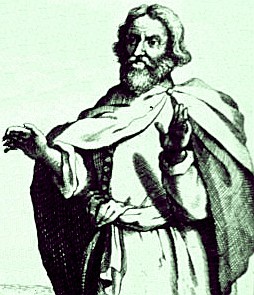
Galen, From De Morbo Attonito Liber Unus,
Title Page (1677)
Writing in the second century, Galen of Pergamon advised that sutures "should be of a material that does not rot easily - the kind that in Rome is called Gallic, which is brought down from the country of the Celts... [which in Rome] is sold very cheaply."4 Mackenzie thinks that Galen was probably referring to linen or celtic thread.5 Galen continued commenting on suturing materials, suggesting that if such thread wasn't available to the reader, "there must be provision of one of the suture materials spun from the so-called silks. ...If this is not available, chose the material most resistant to decay in that place in which you happen to be, like for example the material of dried gut [what we would call catgut], for those materials that readily decay fall off the said vessels."6
While these suture materials worked, they tended to break down rapidly when a wound was infected. Famed ancient Persian medical author Avicenna wanted something better. "In search of more suitable material he turned to pigs' bristles and so invented the first monofilament suture."7 This wasn't widely used during the golden age of piracy (if it was used at all), but is still an interesting development in the history of suture materials.
Closer to the period unders consideration, military surgeon William Clowes advised the use of 'strong, even and smooth silk thread well waxed."8 Sea surgeon John Woodall also suggested the
use of well waxed silk thread.9 Woodall further explains, "It is also convenient to waxe
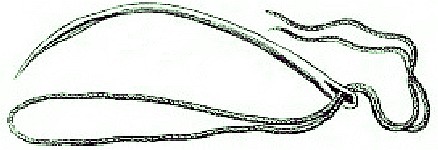
Suture and Needle, From A General System of Surgery,
by Lorenz Heister,
Plate 4 (1770)
the thrid [thread] or silke, or to use some emplaster to rubbe it with in place of waxe."10 The wax (or in Woodall's case, the alternative plaster) was used to help protect the thread from deterioration when it is sewn into the skin.
French surgical teacher Pierre Dionis gave several instructions on how to select suture material to his students."The Thread ought to be even, round, equal, soft, and of a fit fineness or coarseness for the Needle. The Epinay or Florentine Thread [most likely referring here to wool or linen from France and Italy] is preferred to the Silk. ...The Thread is used single or double, pursuant to the force ‘tis to resist, and waxing of it must not be forgotten, that it may not rot but hold the better."11
Obviously a variety of materials could have been used during this time, although the majority recommended linen, wool and/or silk. Surgical historian John Kirkup finds the same thing, noting that these materials were typically the ones used for suturing up until the nineteenth century.12
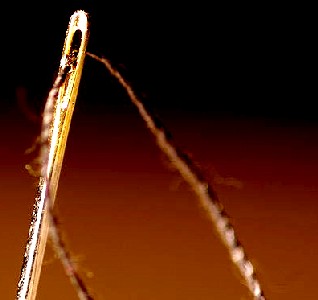
Photo: Wiki Commons user Dmeranda
A rather interesting discussion occurs in the period literature over the use of dyed thread as suture material. John Woodall advises the use of "strong coulored silke well waxed" twice in his discussion on stitching, suggesting the second time that such a thread "is the best to stitch with".13
Pierre Dionis disagrees, suggesting that "when dyed it [the suture thread] cuts the Flesh quicker, all those Dyes being corrosive and caustic."14 He further indicts dyed threads in his discussion on performing intestinal sutures, stating that the suture thread "must be raw, that is, not dyed, because several Drugs enter into the Dyes, which might envenom the Wound by moistning it with them"15.
Dionis may have had a point. Several period dyes and mordants (substances that cause a dye to stick to fabric) were quite toxic and could irritate and infect a wound.16 The type of dye used depended on the color. Among the potentially toxic materials used in dying material at this time were iron or copperas - used in dark colors such as black, olive and silver; tin or stannous - used to brighten colors; copper or verdigris - used to achieve yellows, blues, green and oranges and alum - also used to brighten colors.17 Marx Ziegler's 1677 A Little Dye Book lists iron/copperas, copper/verdigirs and alum in various color recipes.18 Interestingly, all of these metals were also used as medicinal treatments according to various period pharmacopeias, although they were not necessarily applied to open wounds.
1 David Mackenzie, "The History of Sutures", Medical History, April 1973, p. 159; 2 Aulus Cornelius Celsus, Of Medicine, Translated by James Greive, 1756, p. 280-1; 3 Mackenzie,, p. 160; 4 Galen, Method of Medicine, Books 10-14, p. 421, 5 Mackenzie,, p. 160; 6 Galen, ibid; 7 Mackenzie,, p. 161; 8 William Clowes,A Profitable and Necessarie Booke of Observations, for all those that are burned with the flam of Gun powder &c., p. 107; 9 John Woodall, the surgions mate, p. 26; 10 Woodall, p. 26; 11 Pierre Dionis, A course of chirurgical operations: demonstrated in the royal garden at Paris. 2nd ed., p. 38; 12 John Kirkup, The Evolution of Surgical Instruments; An Illustrated History from Ancient Time to the Twentieth Century, p. 312; 13 Woodall, p. 26; 14 Dionis, p. 38; 15 Dionis, p. 54; 16 Thanks to Authentic Pirate Living History Facebook Group Users Daniel Rosen, Beth Weilenman, Matty Bottles and Anne Adkins Berkely for their help in finding material for this section during a discussion on 2/10/15; 17 "Mordants and Metal Dyes", Anne Liese's Fibers and Stuff; gathered 2/11/15; 18 Marx Ziegler, A Little Dye Book, Translated by Patricia Hilts, elizabethancostume.net, gathered 2/11/15
Suture Instruments - Suturing Material: Thread Manufacturing
Much of the linen and wool threads produced were created by individual households
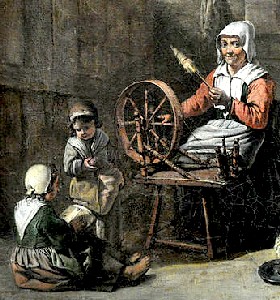
Artist: Abraham Willemsens
Woman at Spinning Wheel in Rouen, France (17thc)
and small artisan manufacturers during this time, usually for production of cloth. Spinning was the process of drawing fibers out of the raw material and twisting them to form thread. "During the 1700s, spinning was not an apprenticed trade but a domestic chore done with spinning wheels"1. Manually operated spindles and spinning
wheels were the only way to make yarn or thread at this time.2
Spinning was such a laborous and time-intensive process that a cloth weaver required 4 - 20 spinners to supply them. To combat this production bottleneck, cloth manufacturers "encouraged spinning as a cottage industry to get cheap labor of women and children in their homes.3
There were some production centers that focused on producing thread. In England, one such thread-making center was in Maidstone (Kent).
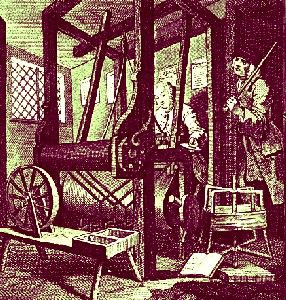
Artist: William Hogarth
Spinning Equipment in Industry, From The
Fellow 'Prentices at Their Looms (1749)
Dutch immigrants introduced thread twisting to Maidstone during the 1560s, and by the seventeenth century Maidstone had become the centre for linen-thread production. The thread was made from flax, most of which was locally grown and retted. It was spun and then passed to the craftsmen who twisted it; after that it was dyed. It was a labour-intensive activity, and in 1664 it was said that 8,000 people in Maidstone were employed in thread twisting.
Maidstone thread was widely exported during the seventeenth century but by 1680 competition from the West Country, where both raw materials and labour were much cheaper, led to a decline in demand for the more expensive Maidstone product.4
By the golden age of piracy, cotten and linen thread appear to have been readily available. Cotton thread was somewhat out of favor during this time period because it couldn't be grown in England and was more expensive than linen.5
Silk was another raw material which wasn't being widely produced in England at this time,
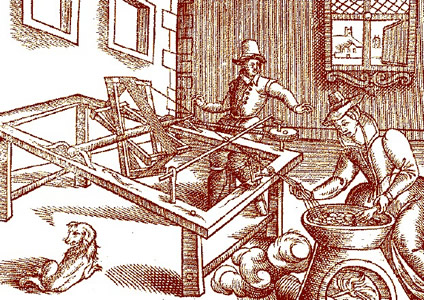
Winding Silk Of the Cods, From The Perfect Use_of Silke-Worms,
by Oliver de Serre (1607)
although there was interest in doing so because it was perceived as a superior cloth. "By the late 17th century, silk, either raw, or as silk thread worked especially by the weavers in Spitalfields, London, was the most valuable of all raw material imports to England."6
Spitalfields became a source of silk manufacture when the Huguenots refugees fled France after the Revocation of the Edict of Nantes in 1685.7 In 1718, Thomas and John Lombe took out a patent for three silk-throwing engines, “one to wind the finest raw silk, another to spin, and another to twist the finest Italian silk into organzine [a silk thread made of strands twisted together].”8 They established their factory in Derby (East MIdlands) in 1721.
It is likely that English surgeons would have been able to procure silk thread thanks to these developments.
1 Ed Crews, "Weaving, Spinning, and Dyeing," Colonial Williamsburg, history.org, gathered 2/11/15; 2 Barbara Meyer, Textiles and the Reformation, sksm.edu, gathered 2/11/15, p. 2; 3 Meyer, p. 4; "Trade, industry and agriculture", hereshitosrykent.org.uk, gathered 2/11/15, 4 Meyer, p. 3; 5 Gerard M. Koot, "Promoting Sil Production in England", Aspects of the Industrial Revolution in Britain, usmassd.edu, p.2; 6 "Industries: Silk-weaving", British History Online,, gathered 2/11/15; 7,8 Koot, p. 4
Suture Instruments - Cannula
\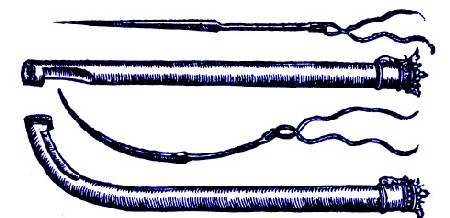
Straight & Curved Needles and Cannulas, From The Workes of that Famous
Chirurgion Ambrose
Pare,
p. 256 (1649)
Surgeons during the golden age of piracy held the skin while suturing using a tube called a cannula.
Ambroise Paré describes a cannula as "a little pipe with a hole or window in the end, which you must hold and thrust against the lip of the wound, that it bee not moved to the one side or other, whilest you thrust thorough the needle. And that wee may see thorough that window when the needle is thrust thorough, and also draw it together with the threed, and withal hold the lip of the wound in more firmly, that it follow not at the drawing forth of the needle and threed."1
John Woodall refers to the cannula as a 'stitching quill', advising his readers,
\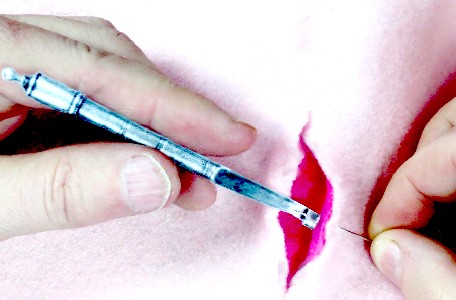
Photo: Raphael Mission - How a Cannula is Used to Suture a Wound
...when you stitch beware you draw not the orifice awry, oblique or deformed, but that you have great respect to the true beauty and former comeliness of the wounded part….let the hole of your stitching quill [cannula] not bee forgotten to be set to the one side of the lippes or sides of the wound which you intend to pierce, so that it may give a stay to [hold firm] the part when it is to be pierced through with the needle, and it must be just so placed that the needle piercing through the wound, may also come within the said hole, which drawne through, take away your quill, and set it so to the other side.2
The primary purpose of the cannula was to hold the opposite side of the wound steady while the needle was poked into the opposite side of the skin. Once the surgeon saw the needle appear in the open section or window of the cannula, he could remove the cannula and reposition it on the other lip of the wound to complete the stitch. Given that needles probably weren't as fine as the suture needles made today, the pressure against the skin probably also made the skin a tauter surface to assist the needle in poking through.
Writing in the early 18th century, French surgical instruction Pierre Dionis highlighted some
\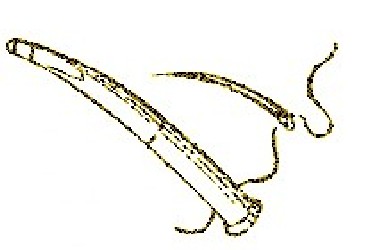
Cannula and Threaded Needle, Pierre Dionis' Cours d'Operations,
From Fig VIII, Les Sutures, p.59 (1740)
interesting features of a cannula. He explains, "The Tube ought to be of Silver, rather curve than straight, in order to be serviceable to all parts of the Body; it should be cut through to give passage to the Needle, and cleft at the end to let the Thread through."3
Dionis is suggesting that a curved cannula would allow the surgeon to place it more easily, making it 'serviceable to all parts of the Body'. Jacques Guillemeu gives additional insight into this in his book, noting that the curved cannula would be "profitable for the sutures of the face, whe[n] the same [sutring] must be done close by the Nose, & in more other places where the extendede, & rectifyede [straight] pipe can not be used."4
The cut in the end ring noted by Dionis (which is more easily seen in Guillemeau's drawing below right) allowed the tube to be left in place while the needle was pulled through window. Guillemeau explained the "end of the sayede needlecase, which is clefte, ther[e] throughe to let the threde the easyer passe through, when as we therwith woulde sowe."5
Cannulas had a secondary purpose - to hold the needles when they were not in use. Medical instrument historian John Kirkup says, "From the sixteenth century, needles were transported inside the handles of stitching quills or cannula"6.
\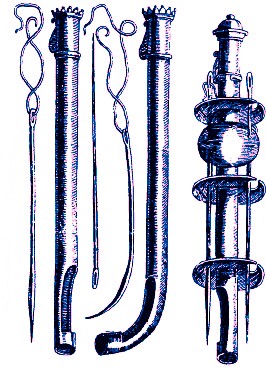
Straight & Curved Needles and Cannulas,
From Jacques
Guillemeau's The French
Chirurgerie (1597)
The long end of the cannula opposite the open tube and window was usually hollow so that the needles could be placed inside. A cap would then be placed on the end to keep them there during transport.
An example can be seen in a pocket kit of surgical instruments dating to 1672. (Images of it are copyrighted, but really bad image of it can be seen on page 130 of the John Kirkup's 1982 article "The history and evolution of surgical instruments II Origins: function: carriage: manufacture" via this link. The canula appears at the bottom of the photo of the instruments; the cap on the end is removed and set slightly off to the side.)
Jacques Guillemeau, student of Ambroise Paré, shows another method of using the cannula to store needles. His figure features two cannulas like Paré's - one curved and the other straight. He includes another image of the straight cannula with a variety of disks and a sphere fitted over it to allow straight needles to be stored on the outside of the cannula. He explains that these additions included "Little round plates of the largenes of a French croune [crown], which are perforatede, wherein the Needles are reservede, and Kepte."7
He still appears to have used a hollow handle to store needles, however. In introducing the cannula, Guillemeau advised that that the needle case was where "we may sticke threadede Needles, & also winde threade thereon."8 He also specifically delineates the cap on the top of the cannula as being "The coverture, or opercle [?] of the sayede case."9 These comments suggest the case was hollow for storing needles in the same way that Dionis explained. It wouldn't make much sense to stow the case with sharp needles on the outside during transport.
1 Ambroise Paré, The Workes of that Famous Chirurgion Ambrose Parey, p. 127; 2 John Woodall, the surgions mate, p. 26; 3 Pierre Dionis, A course of chirurgical operations: demonstrated in the royal garden at Paris. 2nd ed., p. 41; 4,5 Jacques Guillemeau, The French Chirurgerie, (13th unnumbered page in the beginning); 6 John Kirkup, The Evolution of Surgical Instruments; An Illustrated History from Ancient Time to the Twentieth Century, p. 155; 7, 8, 9 Guillemeau, (13th unnumbered page in the beginning)

